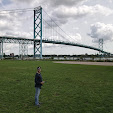The lower Mississippi River basin has a long history of prosperity
and destruction, both at the hands of the river that makes life near it
possible. The Great Mississippi Flood of 1927 was the single most devastating flood
event in the river’s history. Due to that flood, over 600,000 people were
displaced and billions of dollars’ worth of agricultural land along the Delta
were inundated and ruined. Until Hurricane Katrina in 2005, it was the worst
natural disaster in American history.
In the aftermath of this disaster, the United States government
passed the Flood Control of 1928, which gave the U.S. Army Corps of Engineers
the authority to design, construct, and maintain a flood protection system for
the lower Mississippi River and allocated federal funding for the large-scale
undertaking. A series of spillways and flood control structures were planned to
supplement the extensive earthen levee system so that Mississippi River water
could be diverted elsewhere to neighboring waterways in the event of flooding.
One of these diversion structures is the Morganza Control Structure, located
along LA Highway 1 near the city of Morganza. The Control Structure and its
accompanying spillway were completed in 1954 and as of February 2024, it has
operated only twice as a flood control asset.
The Morganza Spillway itself is about eight miles long and
about four miles wide, stretching from the west bank of the Mississippi River
to the east bank of the Atchafalaya River near the village of Melville. A
nearly 4 ½ mile earthen dam was constructed across the spillway just west of
the Mississippi River inlet and the Control Structure was integrated into this dam.
The Control Structure itself is built of reinforced concrete and is about 4,160
ft long and contains 125 gated openings that allow for a maximum flow rate of
600,000 cubic feet per second. That volume is roughly the equivalent of seven
Olympic-sized swimming pools for every second that passes. By comparison, under
normal conditions, the typical flowrate of the Mississippi River at New Orleans
is also roughly 600,000 cubic feet per second. Needless to say, the Morganza
Spillway was designed to handle a huge amount of water as one of the many buffers
against catastrophic flooding along the river in southern Louisiana.
Since its completion in 1954, the Morganza Structure has been used only twice for flood control purposes. In 1973, the spillway was activated to serve as a pressure relief outlet for the Old River Control Structure a short distance upriver. This action is credited with saving the ORCS from failure, as river flooding threatened to undermine and collapse the structure. A second opening of the spillway took place in 2011 when Mississippi River flow rates (which were comparable to those from the 1927 Great Flood) threatened to overwhelm the river’s flood defenses. The immediate consequence of opening the Morganza Spillway or enabling excess volumes of water to pass through the Old River Control Structure, is the inundation of the Atchafalaya River basin and the communities along it between Melville and Morgan City. The decision made by the U.S. Army Corps of Engineers when the flood protection system was designed, was that the rural low-lying areas west of the Mississippi River would bear the brunt of the flooding during these events, with the trade-off being that the state’s largest urban centers in Baton Rouge and New Orleans would remain dry. It’s a trade-off that has its positives and negatives but is seen as essential in order to protect Louisiana’s most valuable economic and agricultural assets.
The following pictures were taken during my February 2023 visit to the Morganza Spillway and the village of Morganza along LA Highway 1. Click on each photo to see a larger version.
The following photos from my February 2023 visit to the Morganza Spillway showcase the northbound crossing of the spillway structure on LA Highway 1. Click on each photo to see a larger version.
The following photos from my February 2023 visit to the Morganza Spillway showcase the southbound crossing of the spillway structure on LA Highway 1. Click on each photo to see a larger version.
Dashcam video of the northbound drive over the Morganza Control Structure on LA Highway 1 was filmed in February 2023 for the 'roadwaywiz' YouTube channel and is available for viewing at the link below:
Dashcam video of the southbound drive over the Morganza Control Structure on LA Highway 1 was filmed in February 2023 for the 'roadwaywiz' YouTube channel and is available for viewing at the link below:
How To Get There:
Further Reading:
Morganza Control Structure by John Weeks
Bridges, Crossings, and Structures of the Lower Mississippi River
Next Crossing upriver: Natchez-Vidalia Bridge (Natchez, MS)
Next Crossing downriver: John James Audubon Bridge (New Roads, LA)
Nearby Flood Control Structure: Old River Control Structure (Lettsworth, LA)
Return to the Bridges of the Lower Mississippi River Home Page
__________________________________________________














Comments